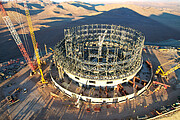Press Release
ESO’s Extremely Large Telescope is now half completed
11 July 2023
The European Southern Observatory’s Extremely Large Telescope (ESO’s ELT) is a revolutionary ground-based telescope that will have a 39-metre main mirror and will be the largest telescope in the world for visible and infrared light: the world’s biggest eye on the sky. Construction of this technically complex project is advancing at a good pace, with the ELT now surpassing the 50% complete milestone.
The telescope is located atop Cerro Armazones in Chile's Atacama Desert, where engineers and construction workers are currently assembling the structure of the telescope dome at a staggering pace. Visibly changing each day, the steel structure will soon acquire the familiar round shape typical of telescope domes.
The telescope mirrors and other components are being built by companies in Europe, where work is also progressing well. ESO’s ELT will have a pioneering five-mirror optical design, which includes a giant main mirror (M1) made up of 798 hexagonal segments. More than 70% of the blanks and supports for these segments have now been manufactured, while M2 and M3 are cast and in the process of being polished. Progress on M4, an adaptive, flexible mirror that will adjust its shape a thousand times a second to correct for distortions caused by air turbulence, is particularly impressive: all six of its thin petals are fully finalised and being integrated into their structural unit. Further, all six laser sources, another key component of the ELT’s adaptive optics system, have been produced and delivered to ESO for testing.
All other systems needed to complete the ELT, including the control system and the equipment needed to assemble and commission the telescope, are also progressing well in their development or production. Moreover, all four of the first scientific instruments the ELT will be equipped with are in their final design phase with some about to start manufacturing. In addition, most of the support infrastructure for the ELT is now in place at or near Cerro Armazones. For example, the technical building that, among other things, will be used for storage and coating of different ELT mirrors is fully erected and fitted out, while a photovoltaic plant that supplies renewable energy to the ELT site started operating last year.
Construction of ESO’s ELT was kickstarted nine years ago with a groundbreaking ceremony. The top of Cerro Armazones was flattened in 2014 to allow for space for the giant telescope.
Completing the remaining 50% of the project, however, is anticipated to be significantly quicker than building the first half of the ELT. The first half of the project included the lengthy and meticulous process of finalising the design of the vast majority of components to be manufactured for the ELT. In addition, some of the elements, such as mirror segments and its supporting components and sensors, required detailed prototyping and significant testing before being produced en masse. Furthermore, construction was affected by the COVID-19 pandemic, with the site closing for several months and production of many of the telescope components suffering delays. With production processes now fully resumed and streamlined, finalising the remaining half of the ELT is anticipated to take only five years. Nonetheless building such a large and complex telescope like the ELT is not free of risks until it's finished and working.
ESO Director General Xavier Barcons says: “The ELT is the largest of the next generation of ground-based optical and near-infrared telescopes and the one that is most advanced in its construction. Reaching 50% completion is no small feat, given the challenges inherent to large, complex projects, and it was only possible thanks to the commitment of everyone at ESO, the continued support of the ESO Member States and the engagement of our partners in industry and instrument consortia. I am extremely proud that the ELT has reached this milestone.”
Planned to start scientific observations in 2028, ESO’s ELT will tackle astronomical questions such as: Are we alone in the Universe? Are the laws of physics Universal? How did the first stars and galaxies form? It will dramatically change what we know about our Universe and will make us rethink our place in the cosmos.
Notes
The percentage completion of the ELT is estimated based on its ‘earned value’, a project management metric used to evaluate progress on a project that accounts for schedule and cost. At present the ELT is 50% through the project plan.
More information
The European Southern Observatory (ESO) enables scientists worldwide to discover the secrets of the Universe for the benefit of all. We design, build and operate world-class observatories on the ground — which astronomers use to tackle exciting questions and spread the fascination of astronomy — and promote international collaboration for astronomy. Established as an intergovernmental organisation in 1962, today ESO is supported by 16 Member States (Austria, Belgium, Czechia, Denmark, France, Finland, Germany, Ireland, Italy, the Netherlands, Poland, Portugal, Spain, Sweden, Switzerland and the United Kingdom), along with the host state of Chile and with Australia as a Strategic Partner. ESO’s headquarters and its visitor centre and planetarium, the ESO Supernova, are located close to Munich in Germany, while the Chilean Atacama Desert, a marvellous place with unique conditions to observe the sky, hosts our telescopes. ESO operates three observing sites: La Silla, Paranal and Chajnantor. At Paranal, ESO operates the Very Large Telescope and its Very Large Telescope Interferometer, as well as survey telescopes such as VISTA. Also at Paranal ESO will host and operate the Cherenkov Telescope Array South, the world’s largest and most sensitive gamma-ray observatory. Together with international partners, ESO operates ALMA on Chajnantor, a facility that observes the skies in the millimetre and submillimetre range. At Cerro Armazones, near Paranal, we are building “the world’s biggest eye on the sky” — ESO’s Extremely Large Telescope. From our offices in Santiago, Chile we support our operations in the country and engage with Chilean partners and society.
Links
Contacts
Bárbara Ferreira
ESO Media Manager
Garching bei München, Germany
Tel: +49 89 3200 6670
Cell: +49 151 241 664 00
Email: press@eso.org
About the Release
| Release No.: | eso2310 |
| Name: | Extremely Large Telescope |
| Type: | Unspecified : Technology : Observatory |
| Facility: | Extremely Large Telescope |
Our use of Cookies
We use cookies that are essential for accessing our websites and using our services. We also use cookies to analyse, measure and improve our websites’ performance, to enable content sharing via social media and to display media content hosted on third-party platforms.
ESO Cookies Policy
The European Organisation for Astronomical Research in the Southern Hemisphere (ESO) is the pre-eminent intergovernmental science and technology organisation in astronomy. It carries out an ambitious programme focused on the design, construction and operation of powerful ground-based observing facilities for astronomy.
This Cookies Policy is intended to provide clarity by outlining the cookies used on the ESO public websites, their functions, the options you have for controlling them, and the ways you can contact us for additional details.
What are cookies?
Cookies are small pieces of data stored on your device by websites you visit. They serve various purposes, such as remembering login credentials and preferences and enhance your browsing experience.
Categories of cookies we use
Essential cookies (always active): These cookies are strictly necessary for the proper functioning of our website. Without these cookies, the website cannot operate correctly, and certain services, such as logging in or accessing secure areas, may not be available; because they are essential for the website’s operation, they cannot be disabled.
Functional Cookies: These cookies enhance your browsing experience by enabling additional features and personalization, such as remembering your preferences and settings. While not strictly necessary for the website to function, they improve usability and convenience; these cookies are only placed if you provide your consent.
Analytics cookies: These cookies collect information about how visitors interact with our website, such as which pages are visited most often and how users navigate the site. This data helps us improve website performance, optimize content, and enhance the user experience; these cookies are only placed if you provide your consent. We use the following analytics cookies.
Matomo Cookies:
This website uses Matomo (formerly Piwik), an open source software which enables the statistical analysis of website visits. Matomo uses cookies (text files) which are saved on your computer and which allow us to analyze how you use our website. The website user information generated by the cookies will only be saved on the servers of our IT Department. We use this information to analyze www.eso.org visits and to prepare reports on website activities. These data will not be disclosed to third parties.
On behalf of ESO, Matomo will use this information for the purpose of evaluating your use of the website, compiling reports on website activity and providing other services relating to website activity and internet usage.
Matomo cookies settings:
Additional Third-party cookies on ESO websites: some of our pages display content from external providers, e.g. YouTube.
Such third-party services are outside of ESO control and may, at any time, change their terms of service, use of cookies, etc.
YouTube: Some videos on the ESO website are embedded from ESO’s official YouTube channel. We have enabled YouTube’s privacy-enhanced mode, meaning that no cookies are set unless the user actively clicks on the video to play it. Additionally, in this mode, YouTube does not store any personally identifiable cookie data for embedded video playbacks. For more details, please refer to YouTube’s embedding videos information page.
Cookies can also be classified based on the following elements.
Regarding the domain, there are:
- First-party cookies, set by the website you are currently visiting. They are stored by the same domain that you are browsing and are used to enhance your experience on that site;
- Third-party cookies, set by a domain other than the one you are currently visiting.
As for their duration, cookies can be:
- Browser-session cookies, which are deleted when the user closes the browser;
- Stored cookies, which stay on the user's device for a predetermined period of time.
How to manage cookies
Cookie settings: You can modify your cookie choices for the ESO webpages at any time by clicking on the link Cookie settings at the bottom of any page.
In your browser: If you wish to delete cookies or instruct your browser to delete or block cookies by default, please visit the help pages of your browser:
Please be aware that if you delete or decline cookies, certain functionalities of our website may be not be available and your browsing experience may be affected.
You can set most browsers to prevent any cookies being placed on your device, but you may then have to manually adjust some preferences every time you visit a site/page. And some services and functionalities may not work properly at all (e.g. profile logging-in, shop check out).
Updates to the ESO Cookies Policy
The ESO Cookies Policy may be subject to future updates, which will be made available on this page.
Additional information
For any queries related to cookies, please contact: pdprATesoDOTorg.
As ESO public webpages are managed by our Department of Communication, your questions will be dealt with the support of the said Department.




